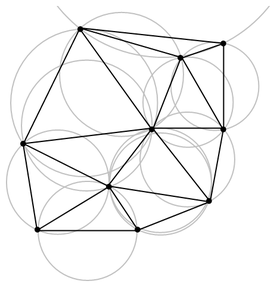Delaunay triangulation

In mathematics, and computational geometry, a Delaunay triangulation for a set P of points in the plane is a triangulation DT(P) such that no point in P is inside the circumcircle of any triangle in DT(P). Delaunay triangulations maximize the minimum angle of all the angles of the triangles in the triangulation; they tend to avoid "sliver" triangles. The triangulation was invented by Boris Delaunay in 1934 [1].
Based on Delaunay's definition[1], the circumcircle of a triangle formed by three points from the original point set is empty if it does not contain vertices other than the three that define it (other points are permitted only on the very perimeter, not inside).
The Delaunay condition states that a triangle net is a Delaunay triangulation if all the circumcircles of all the triangles in the net are empty. This is the original definition for bidimensional spaces. It is possible to use it in tridimensional spaces by using a circumscribed sphere in place of the circumference.
For a set of points on the same line there is no Delaunay triangulation (in fact, the notion of triangulation is undefined for this case).
For 4 points on the same circle (e.g., the vertices of a rectangle) the Delaunay triangulation is not unique: clearly, the two possible triangulations that split the quadrangle into two triangles satisfy the Delaunay condition.
Generalizations are possible to metrics other than Euclidean. However in these cases a Delaunay triangulation is not guaranteed to exist or be unique.
Relationship with the Voronoi diagram
The Delaunay triangulation of a discrete point set P corresponds to the dual graph of the Voronoi tessellation for P.
n-dimensional Delaunay
For a set P of points in the (d-dimensional) Euclidean space, a Delaunay triangulation is a triangulation DT(P) such that no point in P is inside the circum-hypersphere of any simplex in DT(P).
It is known that there exists a unique Delaunay triangulation for P, if P is a set of points in general position; that is, no three points are on the same line and no four are on the same circle, for a two dimensional set of points, or no n + 1 points are on the same hyperplane and no n + 2 points are on the same hypersphere, for an n-dimensional set of points. An elegant proof of this fact is outlined below. It is worth mentioning, because it reveals connections between the two constructs fundamental for computational and combinatorial geometry.
The problem of finding the Delaunay triangulation of a set of points in n-dimensional Euclidean space can be converted to the problem of finding the convex hull of a set of points in (n + 1)-dimensional space, by giving each point an extra coordinate equal to , taking the bottom side of the convex hull, and mapping back to n-dimensional space by deleting the last coordinate. As the convex hull is unique, so is the triangulation, assuming all facets of the convex hull are simplices. A facet not being a simplex implies that n + 2 of the original points lay on the same d-hypersphere, and the points were not in general position.
Properties
Let n be the number of points and d the number of dimensions.
- The union of all simplices in the triangulation is the convex hull of the points.
- The Delaunay triangulation contains at most simplices.
- In the plane (d = 2), if there are b vertices on the convex hull, then any triangulation of the points has at most 2n − 2 − b triangles, plus one exterior face (see Euler characteristic).
- The Delaunay triangulation maximizes the minimum angle. Compared to any other triangulation of the points, the smallest angle in the Delaunay triangulation is at least as large as the smallest angle in any other. However, the Delaunay triangulation does not necessarily minimize the maximum angle.
- A circle circumscribing any Delaunay triangle does not contain any other input points in its interior.
- If a circle passing through two of the input points doesn't contain any other of them in its interior, then the segment connecting the two points is an edge of a Delaunay triangulation of the given points.
- The Delaunay triangulation of a set of points in d-dimensional spaces is the projection of the convex hull of the projections of the points onto a (d+1)-dimensional paraboloid.
- Surprisingly, for a point p inside the convex hull of a Delaunay triangulation, the nearest vertex to p need not be one of the vertices of the triangle containing p.
Visual Delaunay definition: Flipping
From the above properties an important feature arises: Looking at two triangles ABD and BCD with the common edge BD (see figures), if the sum of the angles α and γ is less than or equal to 180°, the triangles meet the Delaunay condition.
This is an important property because it allows the use of a flipping technique. If two triangles do not meet the Delaunay condition, switching the common edge BD for the common edge AC produces two triangles that do meet the Delaunay condition :
-
This triangulation does not meet the Delaunay condition (the sum of α and γ is bigger than 180°).
-
This triangulation does not meet the Delaunay condition (the circumferences contain more than 3 points).
-
Flipping the common edge produces a Delaunay triangulation for the four points.
Algorithms
All algorithms for computing Delaunay triangulations rely on fast operations for detecting when a point is within a triangle's circumcircle and an efficient data structure for storing triangles and edges. In two dimensions, one way to detect if point D lies in the circumcircle of A, B, C is to evaluate the determinant:
Assuming A, B and C to lie counter-clockwise, this is positive if and only if D lies in the circumcircle.
Incremental
The most straightforward way of computing the Delaunay triangulation is to repeatedly add one vertex at a time, retriangulating the affected parts of the graph. When a vertex is added, a search is done for all triangles' circumcircles containing the vertex. Then, those triangles are removed and that part of the graph retriangulated. Done naively, this results in a running time of O(n2).
A common way to speed up this method is sweepline, which involves sorting the vertices by one coordinate and adding them in that order. Then, one only needs to keep track of circumcircles containing points of large enough first coordinate. The expected running time in two dimensions in this case is O(n3/2) although the worst case continues to be O(n2). Its performance at low numbers of points is competitive with divide and conquer (below) but does not scale as nicely above the tens of thousands of points. [2]
Another efficient O(n log n) incremental algorithm keeps the whole history of the triangulation in the form of a tree. The elements replacing a conflicting element in an insertion are called its children. When a parent is in conflict with a point to be inserted, so are its children. This provides a fast way of getting the list of triangles to remove (which is the slowest part of any incremental insertion algorithm).
Divide and conquer
A divide and conquer algorithm for triangulations in two dimensions is due to Lee and Schachter which was improved by Guibas and Stolfi[3] and later by Dwyer. In this algorithm, one recursively draws a line to split the vertices into two sets. The Delaunay triangulation is computed for each set, and then the two sets are merged along the splitting line. Using some clever tricks, the merge operation can be done in time O(n), so the total running time is O(n log n).[4]
For certain types of point sets, such as a uniform random distribution, by intelligently picking the splitting lines the expected time can be reduced to O(n log log n) while still maintaining worst-case performance.
A divide and conquer paradigm to performing a triangulation in d-dimensions is presented in "DeWall: A Fast Divide & Conquer Delaunay Triangulation Algorithm in Ed" by P. Cignoni, C. Montani, R. Scopigno.
Sweepline
Applications
The Euclidean minimum spanning tree of a set of points is a subset of the Delaunay triangulation of the same points, and this can be exploited to compute it efficiently.
For modeling terrain or other objects given a set of sample points, the Delaunay triangulation gives a nice set of triangles to use as polygons in the model. In particular, the Delaunay triangulation avoids narrow triangles (as they have large circumcircles compared to their area).

Delaunay triangulations are often used to build meshes for the finite element method, because of the angle guarantee and because fast triangulation algorithms have been developed. Typically, the domain to be meshed is specified as a coarse simplicial complex; for the mesh to be numerically stable, it must be refined, for instance by using Ruppert's algorithm. This has been implemented by Jonathan Shewchuk in the freely available Triangle package.
See also
References
- ^ a b B. Delaunay: Sur la sphère vide, Izvestia Akademii Nauk SSSR, Otdelenie Matematicheskikh i Estestvennykh Nauk, 7:793-800, 1934
- ^ http://www.gris.uni-tuebingen.de/gris/proj/dt/dteng.html
- ^ Computing Constrained Delaunay Triangulations
- ^ G. Leach: Improving Worst-Case Optimal Delaunay Triangulation Algorithms. June 1992
- Mark de Berg, Marc van Kreveld, Mark Overmars, and Otfried Schwarzkopf (2000). Computational Geometry (2nd revised edition ed.). Springer-Verlag. ISBN 3-540-65620-0.
{{cite book}}:|edition=has extra text (help)CS1 maint: multiple names: authors list (link) Chapter 9: Delaunay Triangulations: pp.183–210. Describes an expected O(n log n) time randomized algorithm for computing delaunay triangulations.
External links
- Real time interactive Voronoi and Delaunay diagrams with source code
- 2D, 3D, and higher dimensional Delaunay triangulation in CGAL, the Computational Geometry Algorithms Library
- Applet for calculation and visualization of convex hull, Delaunay triangulations and Voronoi diagrams in space
- 2D C Delaunay code and Java applet
- C++ 2D Delaunay code
- Mathworld on Delaunay triangulation
- Qhull for computing Delaunay triangulations in 2-d, 3-d, etc.
- Triangle, a 2D Quality Mesh Generator and Delaunay Triangulator (or newer Triangle)
- Triangulate, an efficient algorithm for Terrain Modelling
- G. Leach: Improving Worst-Case Optimal Delaunay Triangulation Algorithms. (June 1992)







